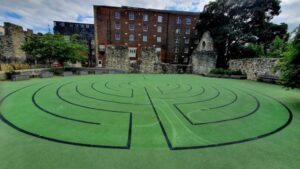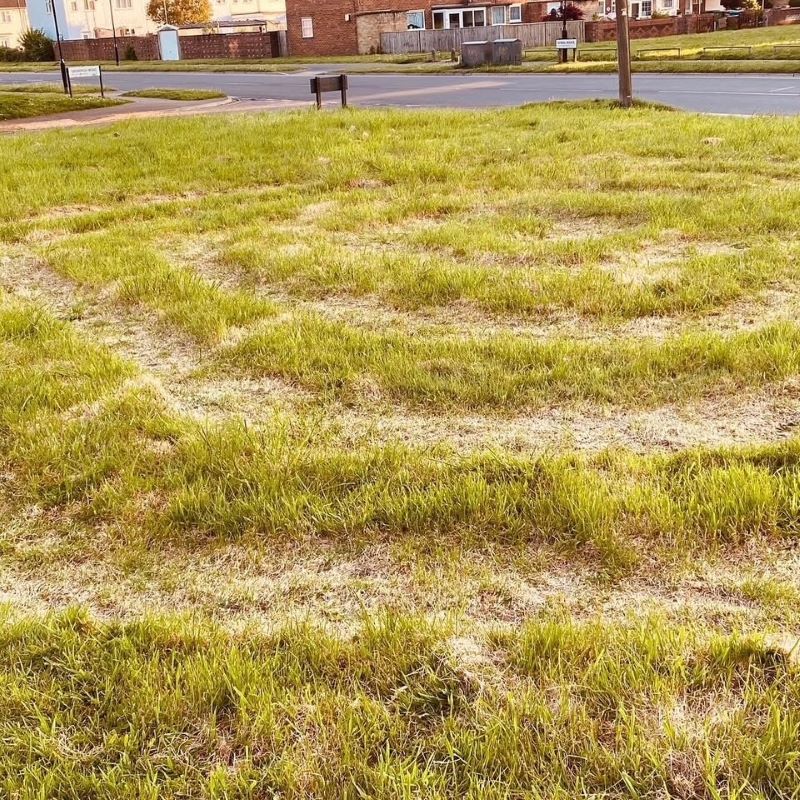By Martin Brisland.
Image – Mizmaze in the grounds of All Saints Church, Millbrook, Southampton
Do you know a labyrinth from a maze and a miz-maze?
We have several examples in our area at Town Quay Park, Redbridge, Breamore and Winchester.
Like me, you may be familiar with the term through the 1986 fantasy film Labyrinth which starred David Bowie as Jareth, the Goblin King. Sarah must journey through his labyrinth in less than thirteen hours to save her baby brother Toby.
In British usage today, the experts say that a labyrinth has one path, and a maze has more than one path.
To get to the central space involves only patience in a labyrinth; but it involves choices in a maze and perhaps getting lost.
Labyrinths have a single continuous path which leads to the divine centre, and as long as you keep going forward, you will get there eventually. In a Labyrinth the way in is the way out. It is a tool for reflection, prayer and healing.
Mazes have multiple paths which branch off and will not necessarily lead to the centre. Mazes arguably derived from labyrinths, slowly evolving to having dead ends and in some cases, traps.
A mizmaze forms a pattern unlike conventional mazes and is classed as a labyrinth because the path has no junctions or crossings. The pattern appears more like a very long rope, neatly arranged to fill the area.
The oldest labyrinths and mazes go back as much as 4,000 years. Some were for decoration and quite small, both indoors and outdoors. Others were big enough for walking – for entertainment, or for a small local journey giving time and space for reflection on life, perhaps for those unable to go on a long walking pilgrimage to a special place.
The oldest known mazes are Egyptian, and possibly served the purpose of keeping looters away from the tombs of the important and wealthy.
The Egyptian maze at Faiyum, beside Amenemhet III’s tomb, which no longer exists, was hailed by some as a wonder of the world with over 3,000 chambers. Pliny, the Roman author, wrote in his book Natural History that the maze at Faiyum had ‘laborious windings with their baffling intricacy.’
The most famous early labyrinth, which housed the mythical Minotaur on the island of Crete, was reportedly based upon the Faiyum maze.
During the Crusades when passage to the Holy Land became dangerous, labyrinths were encouraged for symbolic, spiritual pilgrimages.
The word ‘mizmaze’ seems to be a local word for turf labyrinths in Hampshire and Dorset.
We have local turf mizmazes in the grounds of All Saints Church, Redbridge, Southampton; on St. Catherine’s Hill in Winchester and in Breamore near Fordingbridge.
The Breamore mizmaze has the same pattern and was installed about the same time in the 13th century as the Chartres Cathedral labyrinth in France.

The Town Quay Park artificial surface labyrinth is a simplified version of the Breamore pattern. It was completed in May 2022. It is a labyrinth because it has just one path from the entrance to the centre and back out again.
La Sagesse Convent in Romsey was home to The Daughters of Wisdom from 1888, a French order of Catholic Sisters.
A lawn Labyrinth and a nursing home are today within the grounds.
On St Catherine’s Hill. Winchester is a mizmaze of unknown origin believed to be about 400 years old.
The Winchester Mizmaze is roughly square and one of only two surviving historic English turf mazes where the path is a narrow groove in the turf. The other is at Saffron Walden, Essex.
Turf labyrinths or ‘mizmazes’ have a long history in Europe being recorded as early as the 15th century in Germany. For a while they were scorned by the Church as a pagan symbol.
In English gardens, mazes began to be introduced in the middle of the 16th century and continued to be popular throughout the 17th century.
Sometimes the term ‘wildernesses’ was used. Is thought to refer to their propensity to bewilder people, rather than because they were actually wild areas.
The famous maze at Hampton Court was created in the 1690s for William III.
Many English labyrinths and mazes have been lost. However, some have been restored or recreated for modern visitors including the new maze at Wrest Park in Bedfordshire, and a temporary lawn labyrinth at Whitby Abbey in Yorkshire.
- In Common is not for profit. We rely on donations from readers to keep the site running. Could you help to support us for as little as 25p a week? Please help us to carry on offering independent grass roots media. Visit: https://www.patreon.com/incommonsoton

